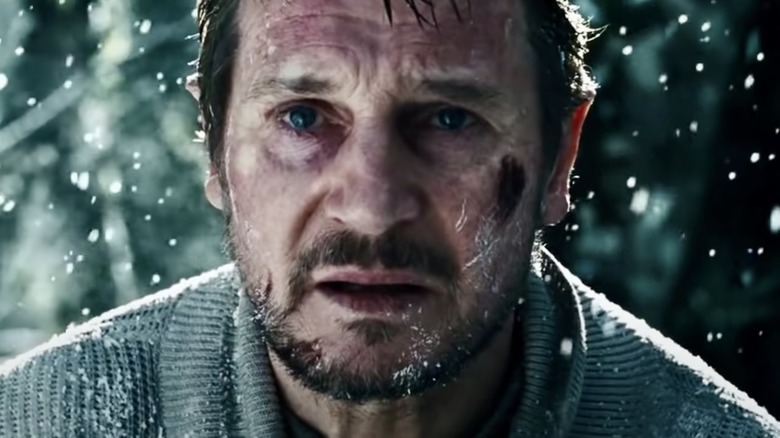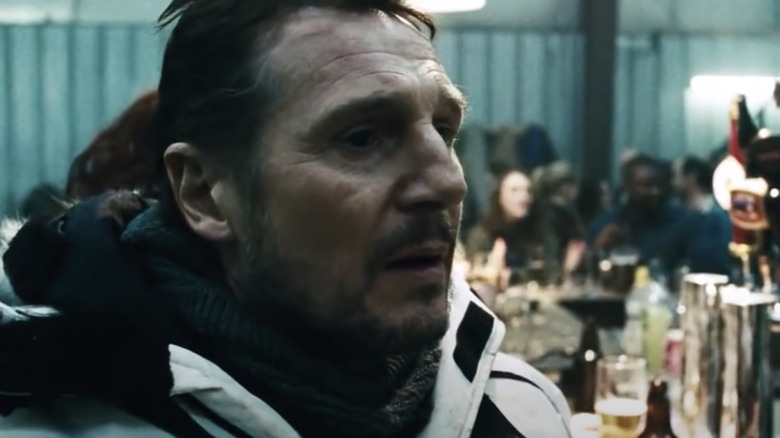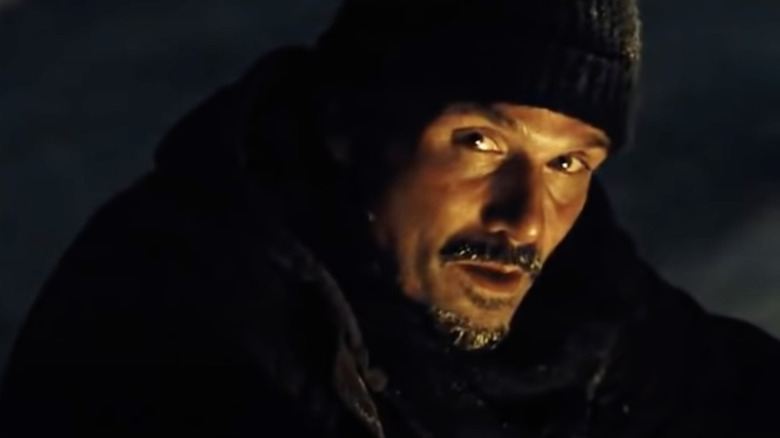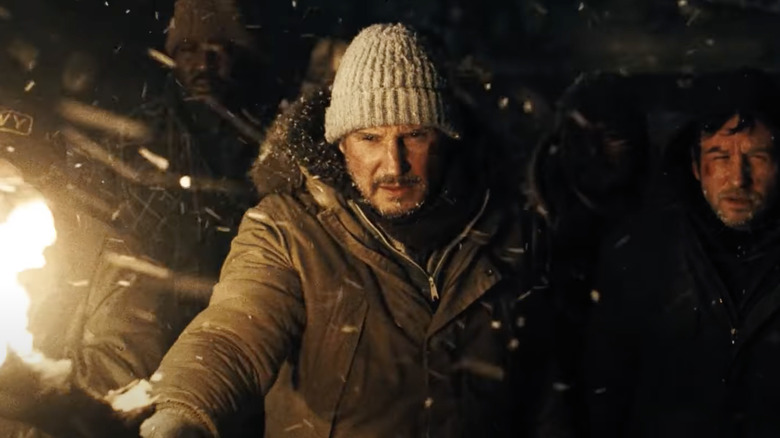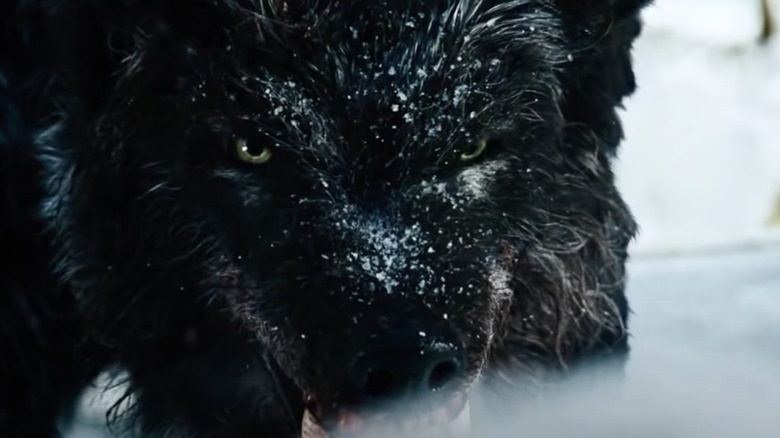Liam Neeson's Best Action Movie Is The Grey
As a casual Liam Neeson fan, it's easy to get some of his latter-day action movie titles mixed up. There's one where he plays a snowplow driver and another one where he plays an ice road trucker, and I'll confess that I had a moment this week where my memory failed me about which of those was which. It was like I became the assassin whose memory is faltering in Neeson's latest action film, "Memory," which just hit theaters on Friday and which was the subject of our recent interview with him.
However, there's one Old Man Neeson (really, Middle-Aged Neeson) movie set in a snowy landscape that I've never forgotten, and that is "The Grey," a film that is still potent and gut-wrenching in its depiction of survival under harsh conditions. Directed by Joe Carnahan, "The Grey" went into wide release in the U.S. in January 2012, so it's celebrating its tenth anniversary this year. When I first saw the movie a decade ago, I remember thinking it was the first great movie of that year.
Cinemascore respondents on opening weekend were not quite as taken (Neeson pun intended) with it. They gave "The Grey" a B minus. Maybe they were expecting a different kind of action movie.
Part of what makes action movies exciting beyond the spectacle of the stunts is the element of danger that arises from chases, fights, and shootouts. "The Grey" sublimates the danger a different way, putting its plane crash survivors in a hopeless situation with life-or-death stakes. Set in the Alaskan wilderness, it's more of an action-adventure and drama than a straight-up action-packed thrill ride.
Carnahan's film was bookended in late 2012 by Ang Lee's "Life of Pi," which likewise used the survival film template to explore deeper philosophical questions, with a tiger taking the place of wolves as the movie's animal of choice. The plot of "The Grey" is also similar to Showtime's "Yellowjackets," another drama where wolves attack plane crash survivors and the title comes color-coded.
A job at the end of the world
In 2002, Carnahan made an auspicious debut with his crime drama "Narc," starring Jason Patric and Ray Liotta. At the time, William Friedkin, the director of "The French Connection" — one of the best cop movies ever made — called "Narc" the "greatest cop movie" he had ever seen. Not every Carnahan film since has lived up to that level of hyperbole, but "The Grey" delivered on the early promise of "Narc," and they both feel like lost '70s movies.
Neeson gives an Oscar-worthy performance in "The Grey," which did receive a limited re-release for awards season, though it went unrecognized. His gruff character, Ottway, enters the frame as a loner, treading through the snow at an oil drilling site with a rifle slung over his shoulder. Through voiceover, we learn that Ottway has taken "a job at the end of the world," in a chilly purgatory, where instead of walking among tombstones, he walks among blue neon crosses and "ex-cons, fugitives, drifters, a**holes, men unfit for mankind."
Inside a rowdy bar, Ottway inhabits his own personal sound vacuum, allowing us to peer inside his head and hear him writing a letter to his MIA wife, where he says, "I move like I imagine the damned do, cursed. I've stopped doing this world any real good."
It does not get much greyer than that. Knowing that Neeson lost his real-life wife, Natasha Richardson, a famous actress in her own right, after a skiing accident in 2009, imbues such moments with even more weight.
Ottway is to wolves what Quint is to sharks in "Jaws." He's employed as a marksman on the site to pick off wolves before they can pick off men. Man-versus-nature stories aren't always terribly compelling when all they have going for them is a conflict against the elements, but soon, Ottway and other roughneck pipeline workers are boarding a plane, which promptly goes down in the wilderness, crash-landing them right in the heart of wolf territory.
Men among wolves
"The Grey" drew the ire of animal rights groups like PETA for its depiction of wolves as bloodthirsty, revenge-seeking monsters, but wolves have been used as a metaphor in art since time immemorial. If wolves are to be valued the same as people, then maybe there are good wolves and bad wolves, just like there are good and bad people. Not every movie has to show them being gentle and dancing with guys named Kevin. Sometimes, they might be there to represent the pitiless gaze of nature, red in tooth and claw, as Tennyson termed it.
In addition to Neeson, "The Grey" wrangles some strong supporting performances out of Dallas Roberts ("Walk the Line," "The Walking Dead"), an up-and-coming Frank Grillo, and his fellow "Purge" franchise alum, Dermot Mulroney, as well as James Badge Dale ("The Pacific," "The Empty Man") and Nonso Anozie, Joe Anderson, and Ben Hernandez. Cinematographer Masanobu Takayanagi, who worked previously with Grillo on "Warrior," brings a gritty handheld camera aesthetic to it. The film also boasts a good soundtrack by Marc Streitenfield and makes memorable use of a piece of music called "The City Surf" by Jamie Winans, first featured in the film "Ink."
"The Grey" furthermore distinguishes itself in the way that its sound design enhances the overall cinematic experience. The howling of the wolves, the blowing of the wind, the cracking of tree branches against a desolate winter terrain ... it all adds up to a harrowing ordeal for both the characters and the audience invested in their fate. Ottway almost takes his own life until he hears the howls of the wolves and regains his senses.
Weighted with questions
What gives "The Grey" heft is its philosophical underpinning, the small debates that arise between characters on the nature of the universe—whether their plight was somehow ordained, or whether they are just here by "blind luck." Roberts and Mulroney play the believers, uttering prayers over fallen comrades and advocating faith, while Neeson and Grillo play the hard-nosed materialists or agnostics who cannot see anything beyond this earthly realm.
Are we just spinning at random through an indifferent cosmos, or is there a higher power who watches over all this? "The Grey" asks the big questions, never easing up on tension as the wolves draw in closer, their snowy white paw prints going red, filling in with man-blood.
Neeson teaches the men how to make bang sticks with shotgun shells on the end of sharpened branches, and they take to fighting back against the wolves. He quotes an existentialist creed from his father: "Once more into the fray, into the last good fight I'll ever know. Live and die on this day."
There's a scene toward the end where Ottway, his present travails continually juxtaposed with idyllic memories of his wife, cycles through an intense mixture of emotions, literally shouting at the heavens. "The Grey" is the kind of spiritual film where you can sit down and watch it and be religious or an atheist and still take something away from it. Speaking to Patheos, Carnahan (who we also interviewed), discussed the questions that fuel the movie, saying:
"I think it's the contradictions that exist in all of us at times in reference to God or to spirituality or to religion in general. There's a duality of a guy calling on God: 'Where are you when I need you?' and then at the same time 'God helps those who help themselves.' I think that contradiction does exist in all of us, those of faith and those who profess to have no faith."
Once more, into the fray
In "The Grey," the wolves are a symbol of the inner struggles and hardships we all face, our physical and mental battles as human beings. There's that saying, "Be kind, for everyone you meet is fighting their own battle," and that has never been truer for this generation than during the pandemic, when the earth suddenly seems to be fighting back against humankind and its deforestation and the environmental havoc it has wrought like something out of a nature-versus-man movie.
"The Grey" is co-written by Ian MacKenzie Jeffers, based on his short story, "Ghost Walker." On the subject of personal pandemic battles, I know that, for me, as an American expat — someone who started out writing online under the pseudonym of "The Gaijin Ghost" — it's been difficult to adjust to a new mode of existence where the only people I interact with on a daily basis (outside typing) are my wife and masked store clerks who are speaking a foreign language.
Before Covid, the job that I had involved conversing with people in person all day long. Even after I started working remotely, I was still Zooming with them face-to-face. Now, as a writer who loves writing but misses socializing, there are times when I leave the house and I feel like Ottway in "The Grey," disconnected from my surroundings, ghost-walking through life.
That's just my own melodrama. For people in more difficult positions, maybe every day is a struggle to survive. In circumstances like those, where you're faced with constant adversity, a person has to draw strength where they can.
By turns propulsive and pensive, "The Grey" is the perfect marriage between the earlier Neeson you might know from "Schindler's List" and the later one from his action-dad phase. Carnahan's film inspires the viewer to pull themselves up by the bootstraps — maybe tape their fists up with some broken bottles between the knuckles — and go out to meet the metaphorical wolves again, repeating Ottway's poem: "Once more, into the fray, into the last good fight I'll ever know. Live and die on this day." And maybe watch "The Grey."
